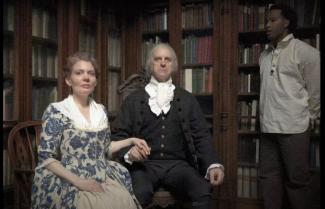
In 2006 and again in 2016, the University of Pennsylvania denied having any connections to the institution of slavery. In 2017, five students under the direction of history professor Kathleen Brown formed the Penn and Slavery Project to investigate those claims, ultimately concluding that Penn both supported and relied on the institution of slavery in its early days. As a Penn undergraduate, I was one of the original five student researchers. After earning my BA in 2018, I served as the project’s public history fellow. Now I am a graduate student at the University of Pennsylvania and the digital historian for the project, managing the website and helping to develop an augmented reality (AR) mobile application. My many roles within the project have shown me that collaborative efforts to challenge simple narratives can uncover truth and lead to change.
The Penn and Slavery Project began with a focus on slave ownership—who owned whom, and when. After looking at the university’s financial records, we concluded that there was no evidence of Penn itself purchasing enslaved people. However, several of the men who founded and funded the university had so much power and wealth that we decided to investigate further. Looking at the tax records and wills of 18th-century trustees and faculty, we identified men who paid taxes on enslaved people and bequeathed them to descendants. We worked to create a bigger picture of these men’s lives, their slave ownership, and their contributions to the university. Over time, however, we began to recognize the importance of expanding our view and complicating our understanding of complicity. The connections between Penn and slavery did not stop with some of the university’s leaders owning other humans, and neither did our research.
Subsequent research into the university’s financial records revealed that Penn built its endowment on the backs of the enslaved. Much like Georgetown University, Penn struggled financially and took drastic measures to stay solvent early on. In 1771 and 1772, Penn sent trustees to Jamaica and South Carolina to collect donations from the wealthiest men in the area: slave owners. These two areas were well known for having plantations with a large number of enslaved people enduring murderous working conditions. This brutality was immensely profitable for the enslavers, allowing them to make generous contributions to the university. The donations collected on these fundraising trips made up about 15 percent of the university’s early wealth.
We began to recognize the importance of expanding our view and complicating our understanding of complicity.
Slave owners’ wealth thus allowed the university’s doors to remain open; it also allowed medical students to train at Penn’s medical school. During lectures, instructors would perform autopsies on bodies of people of African descent, some of them stolen. With these bodies, medical students conducted research and drew conclusions that would support the idea of a biological difference between the races. Their scientific racism produced knowledge that “proved” the intellectual superiority of white people, helped slave owners justify the enslavement of Black people, and legitimized misinformation that still exists in the medical field today.
As our team conducted more research, I started to look at the names on the plaques, buildings, and statues around campus and recognized the men who appeared in our research. Their names, faces, and accomplishments were public knowledge, but their connections to slavery were not. Since the beginning of the project, I understood the importance of gathering information on these connections, but once I knew how the university was honoring these figures, I realized it was crucial that our project fill those gaps in the narrative. And the best way to tell the story of Penn’s history would be to project it on top of the story the university was telling about itself.
The Penn and Slavery Project developed an AR mobile application to serve as a “digital addition” to the historical narrative on Penn’s campus, sharing the project’s research and telling a more complete story of Penn’s past. The app guides users on a campus tour, with each of the six stops featuring undergraduate research through an engaging and interactive AR exhibit.
The tour begins at the heart of campus with the Caesar’s Story stop (researcher: Dillon Kersh) at the statue of Benjamin Franklin. Caesar was an enslaved man owned by Penn’s first English professor, Ebenezer Kinnersley. From 1756 to 1770, Kinnersley received payment from the school for Caesar’s labor, which included lighting fires in the school dormitory and ringing the school bell. We imagined a portrait of Caesar and the Kinnersleys that comes to life in front of Penn’s most famous founder. This stop’s location represents the way Penn and its founders relied on the institution of slavery for their success.
The Slavery’s Science stop (researchers: Carson Eckhard, Archana Upadhyay, and Paul Wolff Mitchell) makes public the history hidden within the Penn Museum. At Edward W. Kane Park, across the street from the museum, the AR exhibit spawns a dome that surrounds the user and displays artifacts, images, and terminology that reveal the connections between Penn’s medical school professionals and the scientific racism their research established. The most notable individual in the stop is Samuel Morton, an 1820 Penn medical school graduate. He collected, measured, and categorized hundreds of skulls to argue that Black people were intellectually inferior and thus best suited for enslavement. He used physical characteristics and skull size to create an intellectual hierarchy, placing white people at the top and Black people at the bottom. His collection is still housed within the walls of the Penn Museum.
Read the entire essay HERE
